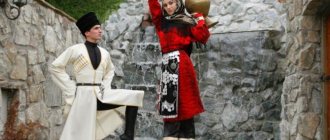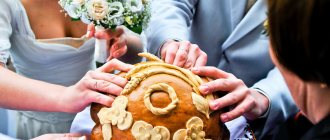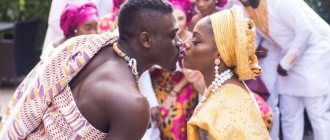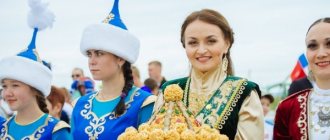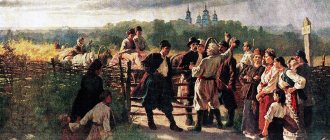Wedding ceremony in the tradition of our Ancestors
The wedding rites of the Slavs, characteristic of the traditional culture of the Slavic-Aryans who lived on the territory of modern Russia tens of thousands of years ago, represent a structurally simple, and at the same time incredibly deep from the point of view of the ideological-figurative paradigm, a system of ritual actions aimed at maximum synchronization of the energy structures of the two of people.
Simply put, in contrast to the essential features of the current institution of marriage, the wedding rites of the Slavs were not reduced to a “stamp in the passport” followed by an enchanting drunkenness. For our Ancestors, a wedding, or rather Lubomir, was a ritual thought out to the smallest detail, which began long before the mass celebration, although such, of course, took place. In fact, the beginning of Lyubomir was the traditional exchange of rings between the bride and groom (“betrothal”, from the Old Russian name for the ring - “hoop”). This action could be performed either in private, without informing anyone, or in the presence of friends or relatives. In any case, the groom notified the bride's family in advance of his intention and without fail received a blessing from both his parents and the parents of his chosen one. In the process of exchanging rings (necessarily silver, because silver is the most energy-intensive metal), the groom gave the bride a ring that he had previously worn for quite a long time, ideally from the age of twelve or sixteen. In return, the bride gave the groom her ring, which she had also worn for many years. However, the rings received by the bride and groom were not worn on the fingers, but were placed on the neck on a silver chain.
The bride and groom had to wear the rings they received for at least sixteen (other sources say forty) days. This allowed each of them to “tune in” to the energy structure of their chosen one. Then, on the appointed day (actually Lyubomir), the bride and groom, in the presence of the sorcerer and relatives, put on each other new rings made especially for them by the family master. At the same time, they returned to each other the rings that they had previously worn around their necks. The new ring was put on the ring finger of the right hand, and the “returned” ring was not on the ring finger of the left hand. As a result, the betrothed “closed” their own energy to each other. From that moment on, they tied their lives and their destinies into an inextricable knot.
The wedding rites of the Slavs, in addition to exchanging rings, receiving a parental blessing and the blessing of a sorcerer on the day of Lyubomir, could include many other events, but they never included “ransoms” and other nonsense that appeared with the advent of Christianity in Rus'. Most often, the groom, in front of the “honest people,” demonstrated his brave prowess in a duel with the brothers or other relatives of the bride. The fights took place with wooden (or steel, but not sharpened weapons), but the men fought at full strength in order to get as close as possible to a real combat situation. A common option was joint hunting, which also allowed the bride's family to evaluate the groom's hunting and military skills.
At the same time, the bride “competed” with the groom’s sisters in handicrafts and culinary disciplines. Singing and the art of dancing played a secondary role, because a woman's ability to manage a household was rightly considered a much more important aspect. The ritual part of Lyubomir necessarily included the exchange of rings in the presence of a sorcerer, and the sorcerer performed a far from nominal function. The priest “attached” the bride’s birth canal to the man’s birth canal. In accordance with the Slavic-Aryan tradition, a woman always entered into a man’s clan, at the same time leaving her own forever. That is why, if for one reason or another the family broke up, the woman could not return to her family, because she was no longer part of it. At the same time, Lyubomir (this was the name of not only the holiday of concluding a family union, but also this union itself) most often could be dissolved only due to the death of one of the spouses. For our Ancestors, the fact of treason or betrayal of another type in the family circle was simply impossible, although it would be correct to note that such moments did occur, but only as exceptions that rightly confirmed the rule, the unshakable canon.
Slavic wedding ceremonies could include a visit to the bride's home, but the main celebration took place at the groom's home. Of course, Lyubomir included a visit to the temple, where the high priest (most often a sorcerer) tied the fates of the lovers. Also, the holiday could be “diluted” with valiant amusements, such as a fist fight or a game of “belts”. In the evening, bonfires were lit, around which round dances were traditionally performed. At the same time, two separate fires were often made for young people, around one of which only boys danced (protivosolon - against the sun), and around the other - only girls (posolon - in the sun). The round dances were positioned in such a way that at a certain point they slightly touched each other. When the priest gave the appropriate command, both round dances stopped and it turned out that one of the guys stopped exactly opposite one of the girls. They were declared a couple, taken aside, and the round dances continued. When there were nine pairs, the round dances dispersed and the priest placed each of the pairs in turn between the fires, their backs touching, but looking in different directions, straight ahead. All participants in the ceremony said out loud “Real! Nav! Rule!”, after which the guy and girl had to turn their heads either to the left or to the right. If they turned out to be looking in the same direction, it was believed that the gods were blessing them. The priest gave appropriate instructions to those couples who passed this unique test. This in no way meant that the couple was necessarily destined to become husband and wife in the future; often it could also be about friendship.
↑ Naming
After birth, usually on the third day (but no later than the 16th day), the child’s parents gave the child a name. The name had to correspond to the inclinations that parents want to show in their child (as you name the ship, so it will sail). But it was forbidden to give the child the name of his father, brother, sister, or in general anyone who already bears this name in the same house. This rule was based on the fact that each person has his own Guardian Leg (angel is a Greek word, in Rus' these creatures were called Legs from the word light transparent) depending on the name, and if in the same house two people are named in his honor , then he is not able to protect each of them.
Until the 17th - 18th centuries in Rus' there was a custom of giving a child, in addition to the official one, a secret name; usually this name was given by a sorcerer or healer and was kept in strict confidence. The worldly name was given by the priest based on the child’s tasks that he must comprehend in this life, that is, this name was temporary, and the secret name is the real name of his soul, which remains forever, no matter in what worlds the person continues to develop further. Therefore, when children reached the age of 9 to 16 years, everything depended on which caste (union approved by the gods) the child belonged to (in the ninth year you need to perform a ritual for the future sorcerer, in the twelfth for the warrior-prince, in the sixteenth for the rest), the priest performed the ritual The naming of an adult estate in accordance with those inclinations that had already clearly manifested itself and if the parents had previously correctly noticed what the child was predisposed to, then the name they gave did not change, but only a secret one was added (Stenka Razin, for example, underwent this ritual, according to legend, at nine years from which we can conclude that he was initiated into the Magi and it was not for nothing that he married couples and performed other rituals).
The naming ritual was usually combined with the initiation rite of receiving a sacred connection with the gods and ancestors. This is a ceremony when a sorcerer gives knowledge that opens spiritual vision to children, through which they can get closer to the Gods. Both rites are associated with the opening of a portal between worlds and require large energy expenditures from the Magus. If the rite of initiation of the sacred connection was carried out separately, then they tried to maintain the same deadlines when the children are between the ages of 9 and 16 years. If this is not possible, the ceremony can be held later, but the quality of the established connection may not be the same.
Before this, from a very early age, all children were raised in love for the Primordial Faith, Gods and Ancestors. A child’s acquaintance with the figurative symbols of his Faith began in infancy with an observation of protective signs and ornaments depicted on toys. The introduction of children to the original Faith of the Ancestors occurred at the ages of 3 to 7 years, because at this age all children from Slavic-Aryan clans had a very highly developed communal thinking. And therefore, education at this particular time was carried out with the help of special game systems that change the architectonics and structure of the brain, and this had to be done in a timely manner. Therefore, from the age of 4-6, the child was unobtrusively taught with the help of games (in no case should the psyche be overloaded) in the art of perceiving information in altered states of consciousness, which made it possible to timely intervene in the emerging structure of the brain and change it during the process, as if to carry out an artificial evolution. Failure to comply with the specified deadlines for information education leads to the fact that the formation of these abilities in an adult is not always possible.
Entertaining forms of real life games were invented for children, where they tried to be like adults. Also, these games were aimed at developing imagination and activating the right hemisphere of the brain, and therefore children freely saw and perceived not only our world of reality, but could also see and communicate with Naval creatures (breaming, brownies, etc.). From the age of six, boys were given paramilitary games. From the age of 7-9, children were taught the basics of the Faith, literacy, numeracy, calculations, writing and natural science. Education was mainly done by men, fathers, and most of them, grandfathers.
When the right time approached, the naming ceremony was performed. During this ritual, children's names were washed off (the ritual took place in flowing water) and instead of the child's name, two adult names were given, one of them was a community one, by which everyone knew the child, and the second was secret, it was kept in deep secrecy and even the father and mother did not know it. The name of the Magus should be denoting happiness, the prince-warrior should be denoting protection, for the rest - expressing prosperity or denoting service. Women's names should be easy to pronounce, not express anything terrible, have a clear meaning, be auspicious and euphonious, and contain an expression of blessing.
And so, after the naming ceremony, they began the professional training of the children, giving them information relevant to their profession and instilling certain skills. After the training, the final rite of ritual initiation into professionals of the chosen type of activity took place. For example, such a ritual was carried out for warriors; at the beginning, the sorcerer sent the consciousness of the young warriors to the world of Navi, performing a special ritual of entering the other world over them. The subjects were laid on the ground, supine, and no one had to talk to them, except for the magicians conducting the ritual. After the initiates communicated with the Heroes Ancestors, their consciousness was returned to the world of Revealing.
Military amulets and weapons were consecrated over the sacrificial fire. Then the future warriors had to undergo four tests. The sorcerer lifted them one by one from the ground and led them to the “fiery river” - a platform of hot coals 5-6 m wide. It had to be overcome at a not very fast pace. The second test was that the future howl had to go blindfolded to an oak tree or family pole (using the phenomenon of clairvoyance). The third test was to test the howl's intelligence and ability to solve complex problems (puzzles were asked). And finally, in the last test, he had to evade pursuit within a certain period of time, hide in the forest or in tall grass, and then make his way through the guard barriers to the sacred oak tree (averting the eyes of others), touching the leaves with his hand. Only after all these tests could a person be considered a real warrior of Perun. After the tests, a gathering was held, where all the ancestors who died in battle were remembered.
Wedding Slavic rituals
The Slavic wedding ceremony is a whole complex of customs associated with a wedding. It consists of several parts and stretches greatly over time (for several months!). Conventionally, Slavic wedding rituals can be divided into wedding rituals themselves, as well as pre- and post-wedding rituals. There are various, sometimes contradictory, data on how the ancient Slavs held weddings. Different territories had their own peculiarities of the ritual, but in general it remained uniform.
Let's start with the pre-wedding rituals:
- Matchmaking. A guy with two matchmakers went to his beloved's house late in the evening. This time was chosen for a reason. After all, if a guy is rejected, then no one will know about it, since they won’t see anything. The matchmakers entered the house with bread and began a conversation with the owners. Only then they called the girl and asked her consent. Matchmakers should be men, sociable and cheerful, so that they can make the owners laugh and talk.
- Bride. This is the next stage of the wedding ceremony. Now the girl’s family comes to visit the guy. This was done to assess how ready he was to start a family. The young man should already have his own farm.
- Engagement. This is a more serious stage when consent to marriage is confirmed. The groom came to the bride with his family. A rich table was set, the hands of the young people were bandaged with towels. After this stage, the newlyweds were considered engaged. And there was no turning back. Refusal to get married was considered bad manners. In addition, it was necessary to pay for “moral damage” and expenses incurred.
- Baking a loaf. This was a whole ritual that was carried out in the girl’s house. All relatives took part. For the preparation itself, married women were called (there had to be an odd number of them). And, of course, while cooking they sang songs and had fun.
- Bachelorette party and gala evening. This is the so-called farewell party. This is goodbye to your past life. That evening they made wedding wreaths. It was also customary to give gifts, dance and sing.
These are the interesting and important events that happened before the wedding. It is important that before the wedding, the future newlyweds had to fast.
But the brightest day, of course, was the wedding. It included:
- Dressing. The bride and groom put on new, specially prepared clothes. As for the attire, the bride should wear a floor-length dress, always with sleeves. On the head is a scarf made of thick fabric. The color of the clothes of the young is white, with numerous embroideries and decorations from evil spirits.
- Invitation (requests). They assembled the wedding train and invited guests. The young people did it themselves. Often the bride gave gifts to those invited.
- Dismissing the young man and paying the bride price.
- Posad. This part of the wedding ceremony was the main one. Now the alliance was considered concluded. The families of the young people gave each other gifts.
- Wedding. Read more about this custom below.
- Coating. This is the final part of the posad. She personified that the girl was now married. Here they distributed the loaf prepared the day before, unbraided the newly-made wife’s braid and covered her head with some kind of headdress. in some territories the braid was even cut off. This custom was the last one to take place at the girl’s home. Then her husband took her to his place. The meaning of the custom of covering was that now the girl should behave differently: more modestly and reservedly.
- Transportation of dowry. Every bride had to have a dowry. It included money or part of the land, as well as bedding and clothing.
Thus ended the wedding day. But that is not all.
After the wedding, there was a custom of hanging the bride's shirt. There should have been traces of blood on it (“viburnum”). Then the matchmaker presented the newly-made wife with a scarf and a red belt. If there was no blood or the shirt was not hung out at all, then such a woman was not girded. According to some reports, if the groom himself made a woman out of a girl, then she was still not awarded a red belt. The hanging took place on Monday morning. Also, after the wedding, it was customary to light the stove and prepare a treat for the father-in-law.
Kalachins are another post-wedding custom. It was needed in order to strengthen relations between families, so that it would be easier for the bride to get used to it. Kalachins were held a month after the wedding in the wife’s house. The newlyweds gave twelve rolls of bread to their parents.
Customs, rituals and traditions of a Slavic wedding
Shortly before the wedding, it was customary to visit the graves of deceased relatives and friends. It was assumed that in this way the future husband and wife received blessings from their ancestors. This action is to feel the relationship with the Family Tree. This is very important for prolongation of the family, when the newlyweds want someone from the family of the husband or wife to be incarnated in their family. Such a close relationship with their ancestors was important for the Slavs of ancient times.
Also, before the wedding itself, it was customary to organize stag and hen parties, which are popular even in modern wedding traditions.
A bachelor party (youth party, or groom’s party) is not so much a tradition as a rite of passage. It could be adhered to either the day before the wedding, or several days before the wedding, which begin from the days of the handshake (betrothal, betrothal, or engagement). The peculiarity of a bachelor party is the ritual feast with peers and friends who are unmarried. This is a farewell to carelessness, single life, festivities and “freedom.” Rituals can be expressed in mysteries - theatrical performances, games with masks on the face, riddles, fairy tales and fun.
A bachelorette party (girl's evening, evening, or bride's party) is a ritual pastime of the bride with her unmarried girlfriends, which takes place either on any day from the day of the marriage, or the day before the wedding itself. This is the time when the bride says goodbye to her girlhood, an easy and simple life, where previously she was not required to have much responsibility and independence. All Russians and Slavs know about the fun and festivities on such a day. However, in the Russian North, a bachelorette party does not begin with fun at all - here you can find crying, lamentations, and poetic regrets. This is how they say goodbye to girlhood and say goodbye to it forever.
Vyunishnik (junins, bypass rite, vyushnik or calling out to the newlyweds) is a bypass rite when the wedding time is marked by congratulations, round dances, glorification, and honoring of the newlyweds who entered into a family union during the current year. This ritual ends the long period of post-wedding time. A Slavic wedding was not a matter of one day, but of a whole period, important for all its participants, and not just for the young. The rite of bindweed or wreath helped newlyweds move from one social status to another, from unmarried to married.
Slavic wedding ceremony
One of the wedding ceremonies was the wedding. It personified the divine blessing of the young for the union. A prerequisite for a wedding was the purity of the bride (virginity). During this ceremony, the newlyweds put wreaths on each other (hence the name - wedding). The wedding took place in a church (usually Svarog or Lada, because they are the patrons of the family).
The most favorable days for the ceremony were Friday, Saturday and Sunday. The future husband and wife were preparing two rings, two towels, two candles, two clay mugs, and a pot of honey for the wedding. The ritual was performed by the Magi. Before the start, it was necessary to line up all the guests and important participants according to certain rules. By the way, the bride and groom were called princess and princes, respectively. Why were pre-prepared attributes necessary?
The newlyweds were also sprinkled with grain. This was done so that many children would be born into the family. Then the young people jumped over the fire three times for purification and blessing by Svarog. The Slavic wedding ceremony also involved passing through some kind of body of water (a river or even a stream). This symbolized the beginning of a new life, overcoming all difficulties together. And in general, customs that are in one way or another connected with natural elements (water, fire) are very characteristic of all Slavic rituals and traditions.
Conclusion
This is how our ancestors spent their weddings: fun and very interesting. For them, the wedding ceremony was one of the most important in the life of every person. They carefully prepared for it. Interestingly, many traditions have been preserved to this day. For example, a bachelorette party, breaking mugs (glasses) for good luck, sprinkling the newlyweds with grain or cereal, bride price. Wedding has also been preserved, but today within the framework of Christianity, not paganism. For the Slavs, a wedding was an event that happened only once in a lifetime. After all, the union was concluded not only on earth, but also in heaven.
LiveInternetLiveInternet
Wednesday, September 03, 2014 00:52 + to quote book
Slavic wedding ceremony. Essence and meaning This ritual is designed to unite two loving hearts, bless them for the creation of life and endow them with the corresponding strength and energy of birth. Starting to consider the Wedding Rite, we must recall that Pokon is an unchanging course, the essence of Life, Existence. Custom is a specifically temporary, regional and tribal manifestation of Pokon in accordance with the period of the Svarog Day (Morning, Noon, Twilight, Night). So, according to the Pokon of the Family of the Almighty, the wedding ceremony can be carried out between an adult man and a woman who do not have blood relatives up to the seventh generation and belong to clans with white skin color. Any departure from Pokon is a distortion of our culture and customs, the moral principles of the Slavs. There were several customs of family unions in Rus'. Our ancestors were familiar with family unions through bride kidnapping, bride purchasing, agreement making and heavenly family union. All of them were inherent in one time or another of the Svarog Day. Heavenly alliances are characteristic of the time of the Morning of Svarozhy, the conclusion of an agreement is the Afternoon of Svarozhy, the purchase is the Twilight of Svarozhy, the kidnapping is the Night of Svarozhy. You and I live in the age of the Dawn of Svarog, the time of transition to the Morning of Svarozh, a return to the Light Customs. So it is important for us to revive the Heavenly Union and the wedding ceremony corresponding to it. Heavenly unions were created for the reason that this is what happens in Svarga Blue, this is how the Light Gods live. This is how we sing about it in our ancestral songs: The dawn has come, the dawn has come, the month has become oppressed. The girl came out into the street, the Cossack has become oppressed. In this song, the dawn is an image of a maiden, and the month is a young man, which speaks of the cosmogony of the idea of family unions among the Slavs. The family union of people is the living one God in Reveal, it is the unity of two particles of one soul. The symbols of heavenly unions among the Rusins (Slavs) are the Moon and Dawn, the Moon and the Sun, Thunder and the Cloud (cloud). But you need to understand that a wedding is only part of a whole series of Rusin wedding rituals. In general, they consist of three parts: pre-wedding, wedding and post-wedding. Without touching on the full ritual stake, we will point out that only the girl who retained her virginity before the wedding has the right to conduct it. Only the girl has the right to perform all wedding ceremonies. It is interesting that the old Russian word “shlyub”, which denotes family unions, means “zlyub”, that is, creating a family with love, for love. The Slavs do not force young people to marry; this custom has long distinguished us even among close Aryan peoples. With the onset of the Night of Svarog, we began to have such a form of union according to Krivda as bride kidnapping. Since the church prevented the implementation of unions without its intervention, and childbirth was losing influence on young people, local priests began to perform weddings in secret. But despite this, up to and including the 19th century. in Rus', a church marriage was not considered a family union until it was recognized by the community through the wedding ceremony (svayba). Families were created “out of love”, therefore this was facilitated by the Tribal Law, which provided for the so-called “trial unions”, when the newlyweds lived together without entering into sexual relations, so to speak, “getting used to it”. When the newlyweds found out that they were suitable for each other and could create a strong family, the Magi gave them the right to get married. Thus, there was no coercion and the girl’s purity was maintained. After the wedding, they always held a “good” or “bad” Monday, when they hung out the bride’s wedding shirt with a “viburnum”, “wreath” or, as they also say, “a maiden’s honor”. Then the matchmaker girdled the young woman with a red belt and put on a rich scarf. When the shirt was not hung out, or it was without a viburnum, the girl’s fate could end quite tragically. In Custom, it was believed that if a matchmaker girds a dishonest young woman, then her children and livestock on the farm may die, and if the groom does this, all the troubles will still pass on to her. Even if the young man himself had something to do with the premature removal of the “wreath,” the bride was not girdled with a red belt. So, premarital sexual relations were not encouraged in Custom, and violators of this right became objects of public censure and contempt in society. What is a wedding? This is the sanctification of the family union by the clan (the entire community, people). The word itself comes from the word “wreath,” because it is with wreaths that newlyweds decorate each other’s heads. For a very long time, the Orthodox Church tried to take over the function of weddings, but even in the 18th century the Rusyns did not recognize church weddings. And the same apostates who, in violation of the Pokon, accepted a church wedding, were prohibited from living together until the family wedding took place. Only in 1744 did the Synod forcibly order the newlyweds to live together before the wedding if they accepted a church wedding. At the moment of the wedding, the Parents bless the family union with the name of their clan and endow the power of their immediate ancestors, and the sorcerer blesses and endows with the Power of the Spirit the entire Russian Family, the entire stingy Slavic Gods. In ancient times, weddings took place in the temples of Svarog and Lada, as guardians of family unions. In the era of the dominance of foreign beliefs, priests consecrated unions in sacred groves near green willows. So now we hold weddings in sacred groves and at the sanctuaries of the Ancestors. The best days for a wedding are Friday, Saturday or week (Sunday). The best wedding day, of course, is the week when “no business”, Dazhdbog Day. To carry out the ceremony, the newlyweds must prepare: two towels, a kalach, two wax candles, two clay mugs (for breaking), a pot of honey, a brush of herbs. The newlyweds should have rings, and the boyar should have a viltse (a coniferous tree symbolizing the rebirth of the newlyweds). All children under 13 years of age invited to the wedding must attend the wedding ceremony. Before the start of the wedding ceremony, the sorcerer arranges the wedding post in this way: in front is the boyar with the wiltz, which symbolizes the rebirth of the young and the greatest honor for the family, the symbol of which is also the wiltz; This is followed by friendship (the boyar’s assistant) with a loaf on a towel, which symbolizes the wealth of the family; followed by the prince and princess (bride and groom); behind them are godly parents (designated parents) with images of Svarog and Lada; behind them are the parents of the prince and princess, and then all the relatives and invitees. Having entered a holy place (temple, sanctuary, temple), the prince and princess stand where the sorcerer indicates, on the right side of them is friendship with the loaf. The boyar and noblewoman stand behind the newlyweds, with wreaths and towels in their hands. Behind the boyars are godly parents with images of Svarog and Lada in their hands. Towels at the ceremony symbolize the family path of the prince and princess; they stand on one towel, and with the other towel they tie/connect their hands (umbilical cord). Clay mugs are necessary for the first family gathering, drinking suritsa. These mugs are broken on the altar stone, which symbolizes the death of the old life and the birth of a new one. Relatives should collect the fragments of the mugs and throw them into the river or running water, which will mean a final farewell to unmarried life, and also so that the river will cut off all the sharp corners of the fragments and life together will be smooth. During the ritual, the sorcerer anoints the princess’s lips with honey before the first family kiss. This action carries the meaning of blessing for a happy, joyful, sweet life. When the newlyweds sow grain, a magical blessing occurs for the continuation of the family, for its increase, so that the Slavs are like grain in a field, like stars in the sky. To complete the ritual, the prince and princess jump over the ritual fire three times, thereby purifying themselves and blessing the power of father Svarog, manifested through Fire God. To summarize the consideration of the wedding ceremony, we will say that this is one of the three most important age-related rites, between the birth and death of a person. When the star halves are married, at the energy level the flows of the power of their spells are connected, two people become one being, one essence, a great soul. Let our holy rites once again resound with mighty Slavic songs throughout our land, for while round dances are performed, while ancestral fires are burning, while Easter eggs are written, our Faith will be, the Slavic people will be! Bogumir MYKOLAEV https://arislav.ru/news_1404102294.html
| Categories: | history of the Slavs Native Gods Slavic traditions white race Slavic trace in history Rodnoverie |
Tags:
history and traditions of the Slavs Slavic wedding wedding ceremony Rodnoverie
Cited 4 times Liked by: 5 users
Like share
0
Like
- 5
I liked the post - Quoted
- 0
Saved
- Add to quote book
- 0
Save to links
Liked5
0
Wedding traditions and rituals of the ancient Slavs
The ancient name of the wedding is Lubomir .
This day was celebrated without alcohol, fights, drunkenness and other indecent behavior. Lubomir is, first of all, a celebration of the soul, and only then of the body. A richly laid table was a secondary task. The tradition of wedding rings is an ancient and complex ritual. They have been preparing for engagement since adolescence. When a boy or girl turned twelve years old, they began to wear a silver ring. It was believed that this metal was sacred and capable of absorbing the positive energy of the owner. At the moment of engagement, the bride and groom exchanged these rings. They had to be worn closer to the heart - on the neck.
With these rings, the couple had to spend from 16 to 40 days, soaking in each other’s energy.
On the wedding day, the bride and groom put other rings on each other's ring fingers of their right hands. Silver ones were returned to the owner and worn on the ring finger of the left hand. This ritual closed the spiritual circle between the newlyweds.
There was no ransom in a Slavic wedding . This is due to the fact that the holiday is spiritual, there could be no talk of any money. On the eve of the wedding, fights were organized between the groom and the male relatives of the bride (father and brothers). This demonstrated the ability of the future spouse to protect his family. Another test option is hunting. The groom showed the bride's father how lucky and dexterous he was in this craft.
The bride had to undergo tests conducted by the female half of the groom. A woman was valued for her knowledge and skills in needlework, cooking, housekeeping, and it is good (but not necessary) for her to be able to sing and dance.
An obligatory part of the wedding day is round dances . The wedding round dance was especially important. It was held at the end of the celebration. Young people came closer to the reservoir and lit two fires on the shore: one for the boys, the other for the girls. The women's round dance was always performed in the direction of the sun; it was called posolon. The male round dance is in the opposite direction, that is, anti-salt.
The fires were so close that the participants in the round dance touched each other's backs. When the sign was given, the round dances stopped and those whose backs touched left the circle. Then, the movement continued. Thus, there were nine pairs. They stood with their backs to each other and pronounced the name of the three worlds (Real, Prav, Nav), then turned their heads to the side. If their direction coincided, then this meant a spiritual connection between people.
The ritual did not mean that these boys and girls had to get married. This was a hint that it was necessary to take a closer look at each other.
Pre-wedding preparation
The process of preparing for the wedding day was laid out in stages and had a strict sequence:
- Matchmaking . Late in the evening, the groom and his matchmakers went to the bride's house. The timing was not chosen casually; if the groom is refused, no one will know about it. Men acted as matchmakers; they were the first to enter the house, treat the owners to bread and start a conversation. Then the bride and groom were called. The girl was asked her opinion, the parents, in turn, looked closely at their future son-in-law.
- Bride . Tests were arranged for the groom, and the girl came to his parents’ house and showed there her ability to manage a household.
- Engagement . The ceremony took place in the bride's house, and relatives from both sides gathered there. In addition to exchanging rings, the newlyweds had their hands tied with a towel. After the engagement, it was no longer possible to cancel the wedding and change your mind.
- Baking a loaf . The action took place in the bride's house. All married female relatives were convened; there had to be an odd number of them. They not only baked bread, but also had fun and sang songs.
- Bachelorette party and gala evening . In other words, farewell evening. That evening they wove wedding wreaths, danced, gave each other small gifts and sang.
Wedding anniversaries by year
Long-standing traditions not only tell how weddings were celebrated in Rus', they do not just stipulate wedding rituals, but also clearly define each wedding anniversary. After all, the culture of marriage used to be very revered, and the family was considered a shrine. That's why they lived together for a long time, sometimes right up to the red wedding. So, what kind of wedding anniversaries exist and what is customary to give on them. We'll look into this now.
Green wedding. This wedding is on the wedding day of the newlyweds. Myrtle leaves in a wedding bouquet are considered a symbol of freshness and youth in a green wedding. Calico wedding. This wedding anniversary is celebrated one year after the wedding. Thanks to an ancient custom, on this day spouses should give each other chintz handkerchiefs - this is a symbol of the fact that there is a pleasant routine in their lives. That's why this wedding is called "calico".
Paper wedding. This wedding is celebrated after two years of marriage. Family ties are not yet fully strengthened, so they can easily break like a sheet of paper. As a gift, it is recommended to give a photo album or calendar, and you can also give banknotes or any glassware. Surely this will be very useful for a young family.
Leather wedding. The third year of marriage from the date of marriage is called a leather wedding. The very name of the wedding says that spouses should cherish each other. And it is recommended to add a small accessory or souvenir made of leather to the main gift. Wax or linen wedding. This wedding is celebrated after four years of marriage. It received the name “linen” because products made from linen are valued more than those made from chintz, so family relationships are considered stronger during this period. The family is already improving its income and entering a period of property accumulation. The name “wax” wedding implies the obligatory presence of candles at the celebration. For this anniversary, it is better to give the spouses linen items (towels, bedspreads, tablecloths). Wooden wedding. This is the spouses' 5th anniversary in family life. On this day, it is recommended to give wooden gifts: various wooden souvenirs will serve as a symbol that your family tree is growing, strengthening and gaining strength. Cast iron wedding. This wedding anniversary is celebrated after six years of marriage. This holiday speaks of an established relationship between spouses, but just like cast iron, family relationships can crack or easily break. According to the old custom, all cast-iron utensils in the house are cleaned on this day and placed on display for all passersby. As a gift for spouses, it is recommended to give cast iron pots and pans, as well as forged grates. Zinc wedding. After six and a half years of marriage, the couple celebrate their zinc wedding. This wedding speaks about relationships, that, like galvanized dishes, you need to periodically shine. Copper wedding. This anniversary is celebrated after seven years of marriage. Spouses should give each other copper coins, which in the future will serve as a symbol of family well-being. Guests are also encouraged to give copper items, dishes or jewelry to this family. Tin wedding. The couple celebrates this wedding after eight years of marriage. As a gift for this family, guests are encouraged to give shiny kitchenware. Faience wedding. After nine years of marriage, a faience wedding is celebrated. Faience is considered a symbol of a well-established way of life. The relationship between husband and wife grows stronger every year. According to the old custom, on this day you need to break all the old dishes, thus you say goodbye to old grievances, misunderstandings and quarrels. Therefore, on this wedding anniversary, it is customary for spouses to give new earthenware. Rose Day. The tenth anniversary of marriage is called Rose Day. And of course, the best gift for this anniversary will be red roses. Those best men who dance with scarlet roses in their hands are invited to this wedding. Steel wedding. After eleven years of marriage, a steel wedding is celebrated. Lived family years are equal to steel; this is already a strong and established family that has strong relationships. For this wedding anniversary, it is recommended to give the spouses a bouquet of 11 flowers. It is believed that if this bouquet lasts 11 days, then these spouses will live together until their death. Nickel wedding. Twelve and a half years later they celebrate their nickel wedding. This holiday says: “Don’t forget to maintain your charm and maintain the shine in your marriage.” Lace or lily of the valley wedding. This wedding is celebrated after thirteen years of marriage. The symbol of this date is fragile flowers, tender as love. As a gift, it is advisable to give clothes made of fine wool or lace items. Agate wedding. After fourteen years of marriage, the agate wedding occurs. Over all the years they have lived together, the spouses have gotten to know each other enough, and at the same time, it is during this period that they learn something previously unknown. Agate protects its owners from many troubles, and spouses also help each other in all difficult everyday troubles. In addition, agate is a talisman of good health and longevity. Therefore, on this holiday it is recommended to give spouses gifts made of agate (beads or agate cufflinks). Glass wedding. After fifteen years of marriage, a glass wedding is celebrated. To make the relationship between spouses transparent and bright, it is recommended to give glass gifts. Turquoise wedding. Eighteen years after the wedding, a turquoise wedding is celebrated. In many families, this time coincides with the coming of age of the first child, so it is during this period that family life appears in a new perspective: the children have grown up, sleepless nights are far behind. Turquoise brings wealth, happiness and success. For this celebration, it is customary for guests to give turquoise products (rings, bracelets, earrings, etc.), the main thing is that the gift is from the heart, as well as beautiful and elegant, because it is a symbol of fidelity and love. Porcelain wedding. The twentieth anniversary of marriage is celebrated as a porcelain wedding. All guests are presented with treats on porcelain dishes. Silver wedding. After twenty-five years, it is customary to congratulate spouses on their silver anniversary. This is a magnificent and solemn holiday in the family. On this celebration, it is customary to give each other silver items, eat from silver dishes and drink from silver cups. It is customary to invite all relatives on this anniversary. And a silver ring is put on the finger with a gold wedding ring. Pearl wedding. After thirty years, the couple celebrates their pearl wedding. A pearl wedding is a symbol of the years lived together - like a string of thirty pearls. Coral wedding. Thirty-five years after marriage, a coral wedding is celebrated. Coral is very durable as it is formed from the skeletons of polyps. The union that has existed for so many years is considered just as strong. According to all traditions, there should be red wine at the holiday, as a symbol of the strength of the union. It is recommended to give spouses a bouquet of thirty-five red roses. Aluminum wedding. This wedding is celebrated thirty-seven and a half years after the wedding. This wedding is evidence of a strong and long-lasting union. An excellent gift for this wedding would be aluminum products. Ruby wedding. The ruby wedding is celebrated forty years from the date of marriage. On this day, it is customary to insert a ruby into a wedding ring - as a stone of fire and love. It is recommended to give jewelry for this anniversary, preferably with a ruby. Sapphire wedding. This wedding is celebrated after forty-five years. It is advisable to insert sapphires into wedding rings this anniversary. This gemstone has strong healing and soothing properties, which is very important for husband and wife at this age. Sapphire also has a positive charge of energy, which will bring good luck in any endeavor. An excellent gift for this anniversary would be jewelry with sapphires. Lavender wedding. Forty-six years later, the lavender wedding comes. Lavender is a symbol of kindness and tenderness, as well as a symbol of long-lasting relationships between spouses. On this anniversary, it is recommended to give these flowers. Golden wedding. The fiftieth wedding anniversary is called the golden wedding. They have lived together for many years and experienced many difficulties, so the spouses experience devotion to each other, boundless love and gratitude. Since the old gold rings are worn out, they are replaced with new ones. Emerald wedding. Fifty-five years after the wedding, the emerald wedding is celebrated. It is believed that the entire life experience of the spouses should be passed on to their grandchildren. The best gifts for this anniversary are items with emerald. Diamond wedding. A diamond wedding is celebrated after sixty years of marriage. Few live to this advanced age, so this holiday is not celebrated often. The couple have lived together for 60 years, their union is strong and indestructible, like a diamond. An excellent gift for this anniversary would be jewelry with diamonds. Iron wedding. This wedding is celebrated after sixty-five years of marriage. The name of the wedding says that although iron is not a precious metal, it is very necessary in the household. The couple preserved their love overcoming all obstacles; their union is equal to the strength of iron. It is recommended to give iron products for this anniversary. Stone wedding. This anniversary is celebrated sixty-seven and a half years after the wedding. We will not destroy such a union of two people. The years lived together speak of the right choice in youth. The gift given to the spouses should symbolize “stone” feelings. Blessed wedding. The seventieth anniversary of the spouses is called the Wedding of Grace. The spouses are grateful to each other for their good fortune, and their children, grandchildren and great-grandchildren toast and give gifts as a token of gratitude. Crown wedding This wedding is celebrated seventy-five years after the wedding. You can learn wisdom and patience from these spouses. An excellent gift for the anniversary would be a cake with swans, which the two of them should cut and distribute to all guests. The heroes of the occasion keep the swans for themselves. Oak wedding The eightieth anniversary of married life is celebrated as the Oak wedding. It is a great happiness to live in marriage for so many years; only people who are devoted to each other are capable of this. Oak products will be an excellent gift for anniversaries. Red wedding. 100 years since the wedding - called the Red Wedding. There is only one known case when a couple celebrated this anniversary. It is recommended to give things and objects of red color.
Stylistics, symbolism and attributes
In order for the wedding day to go according to tradition, the following attributes must be present::
- Rushnik . This is an embroidered piece of fabric in the shape of a long towel. It was the protection of the family and clan, it was passed on from one generation to another. The towel was used to present a loaf or other treat. It was forbidden to step on the towel, as the family would lose the protection of the spirits and doom itself and its descendants to misfortune.
- Homespun towel . It was used to bind the hands of young people during betrothal. Afterwards, the towel was given as a dowry to the bride.
- Loaf . Sweet bread beautifully decorated with curls, flowers, braids. The richer the loaf, the happier and more prosperous the life of the young people was. With the help of the loaf, a ritual of honor to Mother Earth and Father Sky was performed.
- Rings . With their shape they symbolized the sun, which was held in high esteem by the Slavs, then still pagans. The circle is a symbol of harmony, unity and fidelity.
- Wreath of flowers . It was worn by both the bride and groom. A wreath is a symbol of love and sun rays hidden in herbs and flowers.
- Wedding party . An embroidered amulet signifying both the creative and destructive principles of the sun. It means the interweaving of two families and serves as a talisman for a new family. The wedding dress was given by the parents after the wedding ceremony.
How to organize such an event in the old Russian style these days?
Preparation is an important part of organizing a modern Slavic wedding:
- Place of celebration . It is better to choose a lawn, not far from a pond. Another option is a country house or estate in the Russian style.
- Invitations . These can be postcards with folk patterns, decorated with flowers and twigs.
- Menu . There should be dishes of Russian cuisine on the table. Their variety is enormous: cabbage soup, fish soup, pies, pancakes, stewed meat, baked fish, pickles, mushrooms, herring. Instead of a cake, it is better to serve a large berry pie.
- Alcohol . His presence at a Russian wedding is undesirable. If you cannot do without it, then it is better to give preference to Russian drinks: kvass, mead, herbal and berry tinctures.
- Cortege . The ideal option is horse-drawn carts. If this is not possible, then the cars can be decorated with ribbons with folk ornaments and wildflowers.
- The image of the bride . For a girl, it is better to choose a floor-length red sundress with a white, embroidered blouse. A more familiar option is a white wedding dress, trimmed with embroidery in a folk style. On the head is a scarf or a wreath of flowers. The traditional hairstyle is a braid.
- Image of the groom . Consists of trousers, white, embroidered shirt, wide belt and boots.
The celebration scenario is traditional and differs only in nuances:
- Ransom . It is better to refuse money for the bride and ask the groom to show his resourcefulness, dexterity and, of course, love. These can be tasks with dances, songs, ditties and confessions.
- Registration . The best option is outdoors, in nature, not far from a birch grove.
- Wedding . This stage is an obligatory part of a Russian wedding. It takes place according to church traditions.
- Photoshoot . Beautiful photos are taken in a field, a birch grove, on the shore of a lake. Accessories include: flower wreaths, folk-style scarves, wicker baskets, a samovar and a loaf of bread.
- Festive feast . The newlyweds are greeted with bread and salt and seated at a laid table. For entertainment, it is better to choose round dances, dances, harmless competitions, and at the end of the evening - lighting a fire.
A well-planned wedding in the traditional Russian style is a celebration that will be remembered not only by the guests, but also by the newlyweds themselves.
